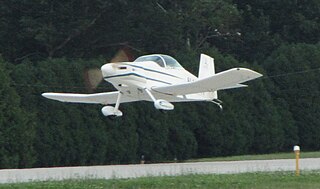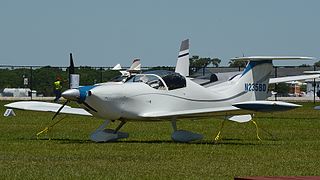| Polen Special | |
|---|---|
 | |
| Role | Homebuilt aircraft |
| National origin | United States |
| Designer | Dennis Polen, Darryl Usher |
| First flight | May 1972 |
The Polen Special, is a homebuilt racing aircraft built to become the fastest four cylinder aircraft in the world. [1]
| Polen Special | |
|---|---|
 | |
| Role | Homebuilt aircraft |
| National origin | United States |
| Designer | Dennis Polen, Darryl Usher |
| First flight | May 1972 |
The Polen Special, is a homebuilt racing aircraft built to become the fastest four cylinder aircraft in the world. [1]
The Polen Special, (Also known as the Polen Special II) development started in October 1967 by Dennis Polen and Darryl Usher. [2] The project to build a fast single seat racer larger than Formula One limitations began as a retractable gear Midget Mustang modification. After reviewing engine installation shortcomings, a clean sheet design was started. The Polen Special was then designed around a Piper Comanche engine and cowling, which also had design issues with engine canting and required cowling modifications for a single engine installation. A new clean sheet Lycoming IO-360 installation came afterward. Two sets of retractable landing gear were built and tested, but were sold to other homebuilders. [3] Over time, the RayJay turbocharger was removed due to hunting and composite ailerons were installed. The aircraft was sold by Polen to Richard C. Keyt and has been modified several times to increase efficiency and safety. A composite rudder replaced the all-metal rudder that fluttered to destruction at 2500 engine RPM and a modern turbocharger was installed. Keyt and partner Jack Zimmanck formed the Polen Company to develop aircraft technologies with the Polen Special as a flying testbed. [4] A design modification called the "Stage 3" is underway incorporate further improvements. [5]
The Polen Special is a low-wing monoplane with retractable conventional landing gear. The retractable gear is hydraulically operated from a T-33 sequencing valve with electric powered gear doors. The fuselage and wings are all aluminum with flush riveting. The ailerons and elevators use push-pull tubes, with cable control for the rudders. [6] The aircraft is specifically designed to fly at high altitude on IFR routes with the pilot using supplemental oxygen to achieve maximum speed with the turbocharged engine. [7]
Data from Sport Aviation
General characteristics
Performance
Aircraft of comparable role, configuration, and era

The Thorp T-18 is an American, two-place, all-metal, plans-built, homebuilt aircraft designed in 1963 by John Thorp.
The Titan T-51 Mustang is a three-quarter scale replica of the P-51 Mustang that was designed by Titan Aircraft owner John Williams. It is a two-seat homebuilt aircraft with dual controls and tandem seats, and has remarkable performance given the small size of the engine.

The Lancair Legacy, a modernized version of the Lancair 320, is a low-wing two-place retractable-gear composite monoplane, manufactured by the American company Lancair. It is available as a kit that cost US$71,500 in 2011. There is also a fixed-gear version, the Legacy FG. The retractable version of the Legacy cruises at 276 mph at 8,000 ft and the fixed gear version cruises at 215 mph.

The Jurca Gnatsum is a French homebuilt near scale replica aircraft based on the North American P-51 Mustang.

The Jurca MJ-5 Sirocco is a two-seat sport aircraft designed in France in the early 1960s and marketed for homebuilding. It is one of many wooden homebuilt designs from Romanian born designer Marcel Jurca. Jurca, a Henschel Hs 129 pilot in World War II marketed the plans in Canada and America through Falconar Aviation. It is a low-wing cantilever monoplane of conventional configuration and wooden construction throughout. The tandem seats are enclosed by a bubble canopy, and the tailwheel undercarriage can be built as either fixed or with retractable main units. Marcel Jurca died on 19 October 2001, at which time plans were still available from the designer's web site.

The Sindlinger HH-1 Hawker Hurricane is a ⅝ scale homebuilt design based on the Hawker Hurricane. Designed by Fred Sindlinger for amateur construction, the prototype was built between 1969 and 1972.

The Fisher Celebrity is a Canadian two-seat, conventional landing gear, single engined, biplane kit aircraft designed for construction by amateur builders. Fisher Flying Products was originally based in Edgeley, North Dakota, United States but the company is now located in Dorchester, Ontario, Canada.
The Lucas L6 is a French all-metal monoplane design for homebuilding by Emile Lucas.
The Mini Mustang was a scale replica of the P-51 Mustang. It featured aluminium construction and manual retractable landing gear.

The Prescott Pusher is an American, four-seat, pusher configuration homebuilt aircraft, with a large cockpit, retractable or fixed gear and a T-tail. The pilot and passengers enter the aircraft through a large left-side clamshell door.

The Stolp Starduster Too SA300 is a two-seat, conventional landing gear equipped homebuilt biplane. Aircraft Spruce & Specialty Co currently holds rights to sell plans for the aircraft.

The Salvay-Stark Skyhopper I is a low-wing single-place homebuilt aircraft designed in 1944.

The MacFam Cavalier is a homebuilt aircraft designed by Stan McLeod, developed through a progressing series of models, all using all-wooden construction. The model range includes the SA102, SA102.5, SA103, SA104 and the SA105.

The Wickham B is an American experimental twin engined, homebuilt aircraft.
The Falconar SAL Mustang, also called the 2/3 Mustang and the SAL P-51D Mustang is a Canadian amateur-built aircraft, originally produced by Falconar Avia and introduced in 1969. The aircraft is a 2⁄3 scale replica of the North American P-51 Mustang and is supplied as a kit or as plans for amateur construction.

The Alvarez Polliwagen is a 1970s homebuilt aircraft. The aircraft has a combination of many high performance features not typically found in a Volkswagen air-cooled engine-powered homebuilt.
The Glassic SQ2000 is an American homebuilt aircraft, designed and produced by Glassic Composites LLC of Sale Creek, Tennessee. When it was available the aircraft was supplied as a kit for amateur construction.
The Sea Storm is an Italian homebuilt amphibious flying boat that was designed and produced by Storm Aircraft of Sabaudia. Storm Aircraft was originally called SG Aviation srl. When it was available the aircraft was supplied as a kit for amateur construction.
The Stewart S-51D Mustang is an American aerobatic homebuilt aircraft that was designed by Jim Stewart and produced by Stewart 51 of Vero Beach, Florida, introduced in 1994. When it was available the aircraft was supplied as a kit for amateur construction.

The ScaleWings SW51 Mustang, formerly marketed as the FK-Lightplanes FK51 Mustang, is an Austrian ultralight, light-sport aircraft and homebuilt aircraft that was designed by ScaleWings of Strasswalchen, Austria and was initially produced by FK-Lightplanes of Krosno, Poland, who introduced it publicly at the AERO Friedrichshafen show in 2013. After FK-Lightplanes ceased production, the design was built by ScaleWings.
{{cite journal}}: Missing or empty |title= (help){{cite journal}}: Missing or empty |title= (help){{cite journal}}: Missing or empty |title= (help)| Wikimedia Commons has media related to Polen Special . |